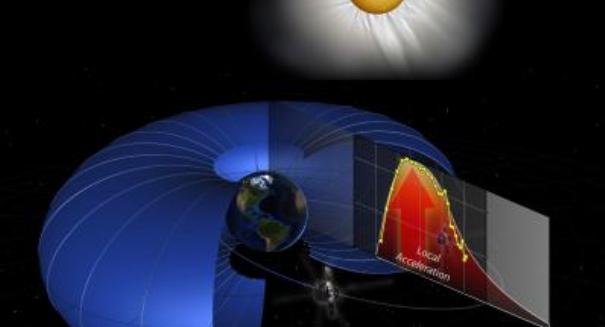
The scientists identified a rapid energy increase of high-energy electrons in the belts on October 9, 2012.
Scientists have discovered a massive particle accelerator in the Van Allen radiation belts. Previously, scientists knew that something in space accelerated particles in the radiation belts to 99.9 percent of light speed but they weren’t sure what the something was. Now, new data from the Van Allen Probes suggests that the acceleration energy comes from within the belts themselves. According to scientists, particles residing inside the belts are sped up by local kicks of energy, moving the particles to ever greater speeds.
The source of the acceleration is a region of intense electromagnetic waves, obtaining energy from other particles located in the same region. Identifying the location of the acceleration will help scientists upgrade space weather predictions, because changes in the radiation belts can be harmful to satellites that circle close to our planet.
The Van Allen Probes were specifically designed to journey straight through this region of intense electromagnetic waves. When the Van Allen Probes launched in 2012, the mission goals were to determine how particles in the radiation belts are sped up to extremely high energies, and how the particles can from time to time escape.
The Van Allen radiation belts were first discovered by Explorers I and II. Shortly after their finding, it became clear to scientists that the belts represented some of the most hazardous environments a spacecraft can endure. When the radiation belts swell due to incoming space weather, they can surround spacecraft, exposing them to dangerous levels of radiation. With enough warning, however, spacecraft could be shielded from the worst effects.
First author Geoff Reeves, a radiation belt expert at Los Alamos National Laboratory notes that the belts are in a “constant state of change.”
According to astronomers, the belts don’t even change consistently in response to what seems to be similar stimuli. While some solar storms caused the belts to intensify, other solar storms reduced the belts. Furthermore, some solar storms seemed to have almost no impact on the belts. Determining where the energy that accelerates the particles originates will assist scientists in their quest to better predict which solar storms will intensify the radiation belts.
The Van Allen Probes were also designed to determine the difference between two possibilities on what processes accelerate the particles: radial acceleration or local acceleration. In the first scenario, particles are sent perpendicular to the magnetic fields that surround Earth, from regions of low magnetic strength far from Earth to regions of high magnetic strength nearer Earth. In the second scenario, particles obtain energy from a local energy source.
Using two sets of data from the Van Allen Probes, scientists can examine the particles and energy source in two areas of space simultaneously, giving them the ability to make a distinction between processes that occur locally or originate from great distances. Sensors on the spacecraft which determine particle energy and position and measure pitch also give scientists that ability to discern between the two processes.
The scientists identified a rapid energy increase of high-energy electrons in the belts on October 9, 2012. Instead of revealing an intensification that began first far from Earth and traveled inward, the data showed an increase in energy that started right in the middle of the belts and gradually spread both inward and outward, leading scientists to conclude that a local energy source is responsible for the acceleration of the electrons.
Scientists believe that these new findings will improve predictions of the solar storms that intensify the radiation belts to levels that can harm satellites.
Leave a Reply